#orthocone
Text
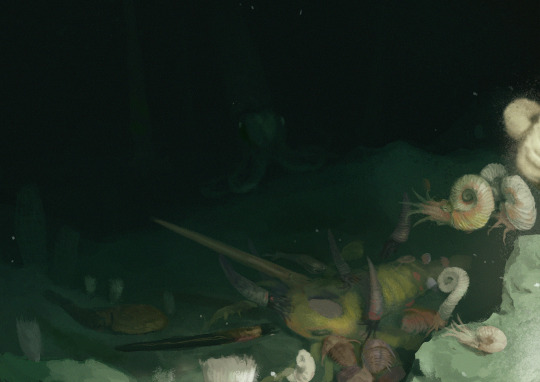
POV: you went diving at night and spotted Ordovician nautiloids feasting on a eurypterid carcass, after a while the commotion has attracted the giants, Endoceratids slowly creeping into view
#illustration#art#paleo art#paleoart#palaeoblr#ordovician#palaeontology#nautilus#nautiloid#cephalopod#eurypterid#orthocone#trilobite#palaeozoic#endoceras#endoceratid
8K notes
·
View notes
Text
Hasellia's rock collection 06.07.23

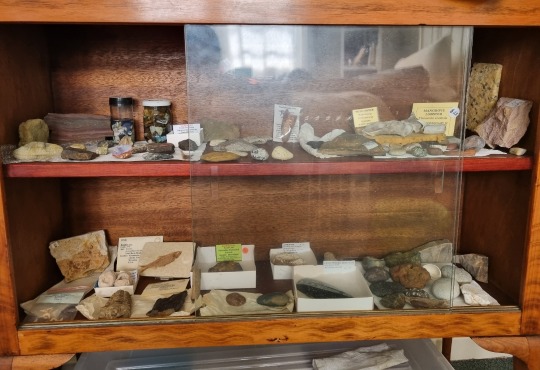

#rock collection#most of these are either from the beach or rock shows#excuse the junk on my cabinet#and reflections...#It was bright today and I've been wanting to upload my rocks for a while but it didn't really come out good oh well#geology#rocks#fossils#mud lobster#lobster#paleontology#Knightia#Knightia alta#Trilobite#crinoid stem#ammonite#Orthocone#Fossil cocoon#cocoon#shark teeth#Spinosaur#Spinosaur tooth#Sea urchin#Tetragramma violare#eucalypt leaf#fossil leaf#sedimentary rock#metamorphic rock#tigre iron
54 notes
·
View notes
Note


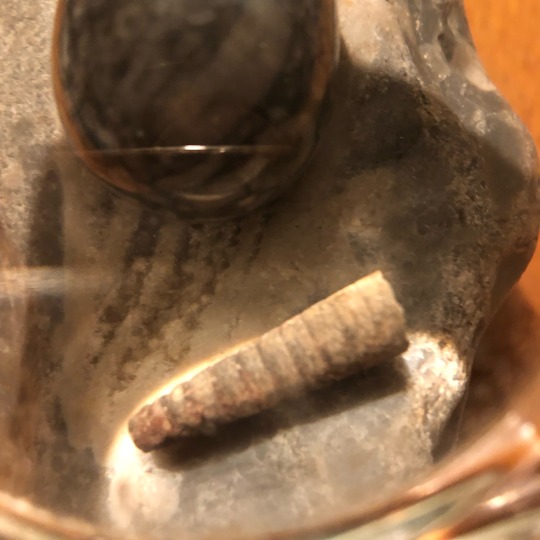

Hello, i have an ask from the pics. Are these an Crinoid stem ?

These are little ones from the kids activity to dig and search sets from those Dinosaur parks / museum bags. Likely all shells & sponge right?
Hi! :D
So I'm gonna start by saying, I am most definitely an amateur, haha, so my word is not 100% certain, but,, I think I may have some news for you!
The segments in those pieces do resemble some Crinoid stems and columnals I've seen, but I've never seen a stem that varies in diameter like those. Yeah, it could be erosion, but the fact that it is all of them, the same precise, cone shape is a little suspicious!
But guess what else is segmented! Nautiloid shells! and guess who evolved straight shells quite a few times! Nautilods!! I believe what those are is Orthocones! (straight, long, shells of Nautiloid Cephalopods) (a squid-like animal, with a shell) They were around from late Cambrian to the late Triassic:) And in size, they range from less than 25 millimeters to over 5 meters!
Here is an example of an Orthocone!

looks pretty similar to yours, do you think?
That is so awesome, friend! Yeah, Crinoids are awesome too, but you definitely do have some of those in that polished egg (It's so pretty)
Also check out this huge one!
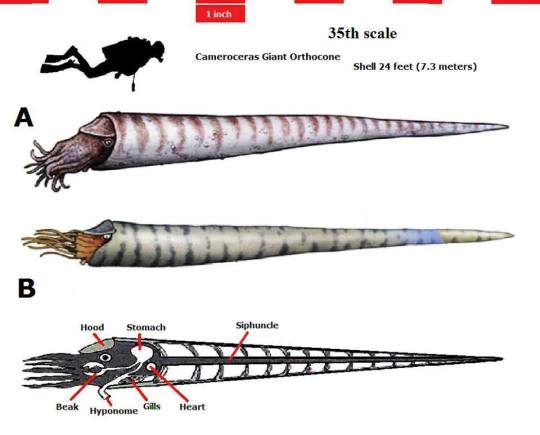

also yeah, the stuff from the museums and kits looks like shells and sponges to me, but again, im not a professional :) and I mostly know brachiopods haha
Thanks for showing me your cool fossils! They are lovely, I can imagine that joy you felt when you found them! Isn't fossil hunting the best thing ever!?! :) You're blog is inspiring me so post more of my fossils!
Oh, and if you want, give your Orthocones a little kiss for me! (I love to give my fossils a little peck, pretty cool to be able to kiss something that's millions of years old, right?)
#orthocone#nautiloid#cephalopod#fossils#ask:)#fossil#fossil collecting#paleontology#fossil hunting#nautilus#nautiloid fossil#cephalopod fossil#amateur paleontology#orthocone fossil#crinoids#crinoid
7 notes
·
View notes
Text
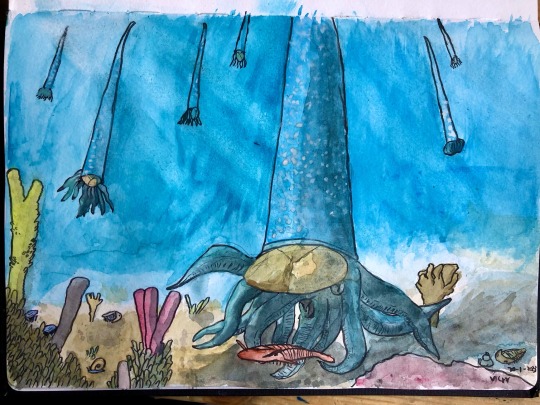
An Endoceras orthocone descends upon an unsuspecting Pseudogygites trilobite. While they are often reconstructed swimming sideways, recent studies have shown orthocones actually swam upright in the water column, so I drew them more like a claw game, grabbing prey from the sea floor.
#edoceras#pseudogygites#orthocone#endocerid#asaphid#cephalopod#trilobite#arthropod#cw: bugs#tubulate coral#bryozoa#brachiopod#ordovician#paleoart#palaeoblr#paleoblr#this trilobite has actually been found with an orthocone having taken a bite out of it
39 notes
·
View notes
Text
Drew a drawing of myself.
(And some doodles of prehistoric life)

#self insert#self portrait#slavic#paleo meme#paleoillustration#paleo art#paleontologist#paleoblr#thylacine#dunkleosteus#pterosaur#orthocone#cameroceras#traditional illustration#illustration#illustrator#sketch#sketchbook
4 notes
·
View notes
Text
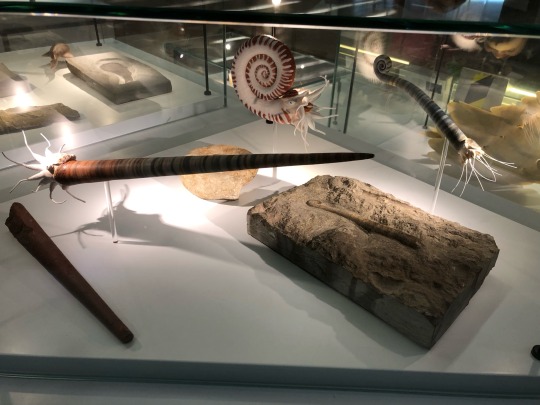
Ordivician cephalopods. The orthocones should probably be updated to be swimming vertically, but on the other hand the display is not tall enough for that.
3 notes
·
View notes
Photo






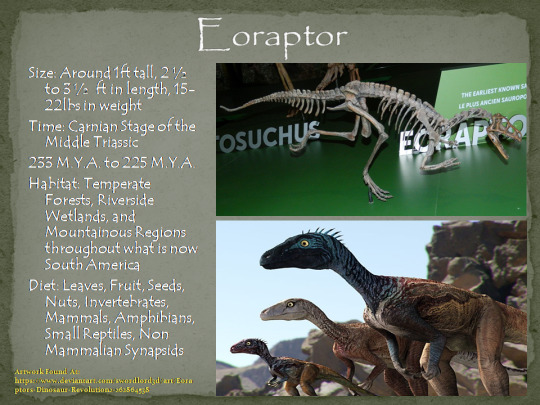

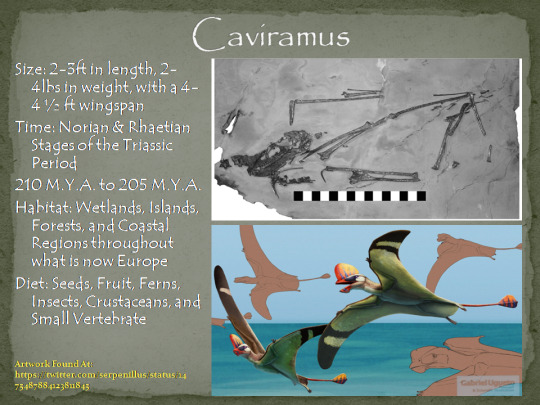

mesozoic batch 1
#Mesozoic#orthocone#orthoceras#gojirasaurus#plateosaurus#caviramus#lystrosaurus#helicoprion#eoraptor#herrarasaurus#triassic#dinosaur#pterosaur#synapsid#thrinaxodon
5 notes
·
View notes
Text
Some silly prehistoric guys based on creatures from the Palaeozoic Era 🦐‼️
They like to collect human objects and stash them in their secret gang hideout <:]

Here is a closer look at the members of the group:

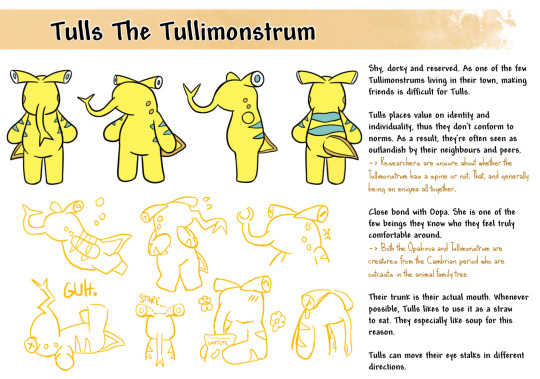



#opabinia#trilobite#aegirocassis#tully monster#cameroceras#orthoceras#giant orthocone#paleozoic#cambrian#cambrian period#ordivician#paleontology#paleoart#paleoblr#suis arts#ocs#oc#cambrian explosion#soups up!
35 notes
·
View notes
Text
Announcing Woodward Wednesdays

I have for a while wanted to post paleoart by the regrettably underappreciated early paleoartist, illustrator and a pioneer of females in paleoart, Alice B. Woodward. I originally planned a big post for International Women's Day, but my inability to keep on schedule scuttled those plans.
To make up for that mistake, I'm announcing a recurring weekly theme: Woodward Wednesdays! I'll be sharing some select works by Alice Woodward that I've been trying to clean up and retouch from old scans of books, so they won't be quite on par with scanned or photographed originals, which if exist are behind paywalls. Hopefully they'll be some of the best freely available versions of her works anyway.
As a taster of things to come, I want to kick things off with three rarely reproduced images from Evolution in the Past by Henry R. Knipe, from 1912.

This untitled illustration faces the title page, and is more symbolic than realistic, but showcases Woodward's talent more generally as an illustrator.

Titled "Silurian Marine Life" this piece almost feels like a still life, and simultaneously could be a neat little museum diorama. Also that orthocone is strangely adorable.

While it's Woodward's work on dinosaurs that most usually gets remembered in our time, she also illustrated both Paleozoic and Cenozoic life, perhaps more than Mesozoic taxa. This piece features Inostrancevia hunting pareiasaurs from the water, a highly dynamic scene the like of which I do not believe I've seen in paleoart either from this era or after.
48 notes
·
View notes
Text
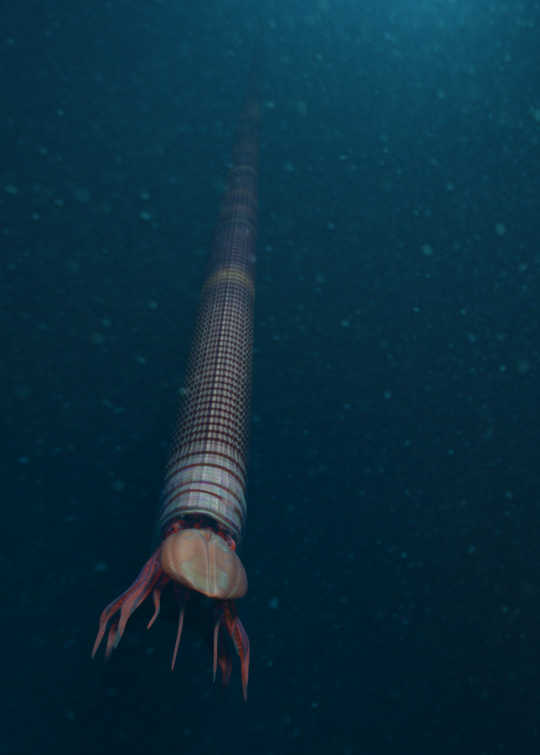
Dawsonoceras is another cephalopod that swam the waters of Sillurian Gotland. They are an orthoceratid straight-shelled nautilid that floated in a vertical position on the water collumn.
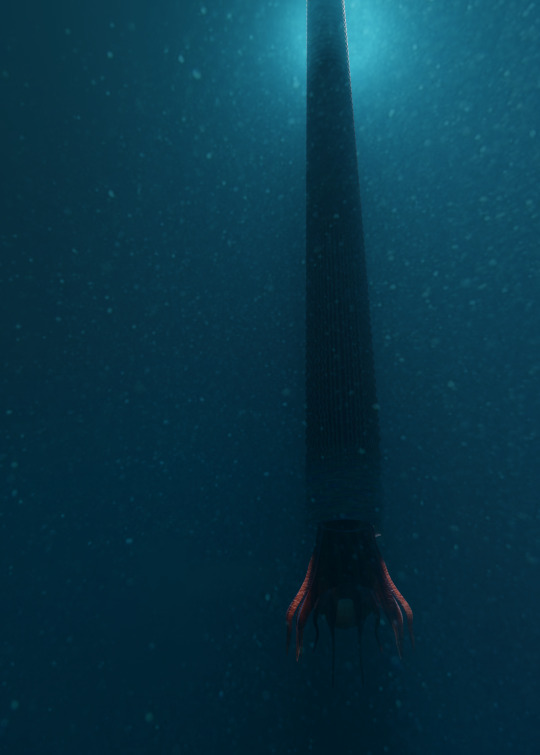
Although they are far smaller than some of the other orthocones and endoceratids that reached lengths of up to 5 meters, their shell is just as beautiful to behold.
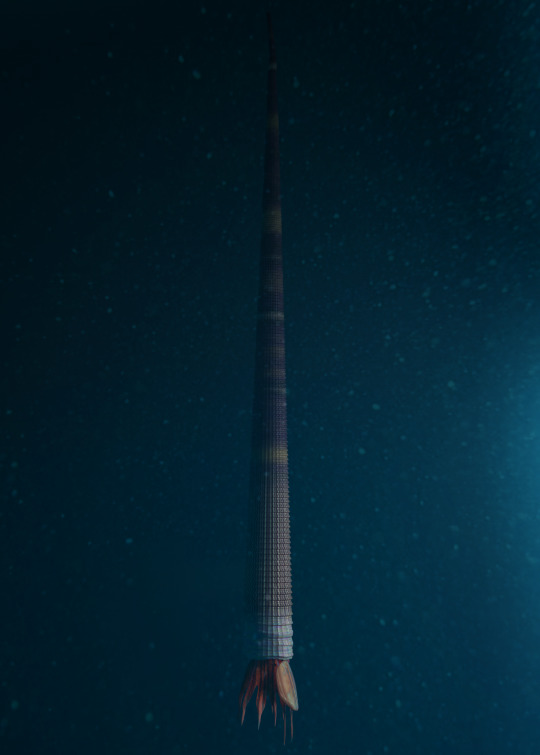
Kröger, B. (2013). The cephalopods of the Boda Limestone, Late Ordovician, of Dalarna, Sweden. European Journal of Taxonomy, (41).
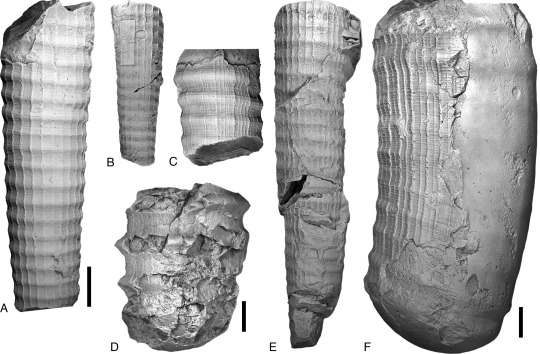
Above specimens A,B, & E are dawsonoceratids, Scale bars: 10 mm.
From what I can gather, their adult shell diameter reaches 2.5 cm wide and it's hard to guess the total length because a lot of the shells are fragmentary. There seems to be one complete specimen online that was described to be 7.1" inches long
And another here that's 40 cm long, although it's an ID-guess from the blog poster
#paleoart#palaeoblr#paleontology#cephalopod#blender#blender3d#3d model#3d art#3d modelling#3d#orthocone#dawsonoceras#silurian#gotland
512 notes
·
View notes
Photo
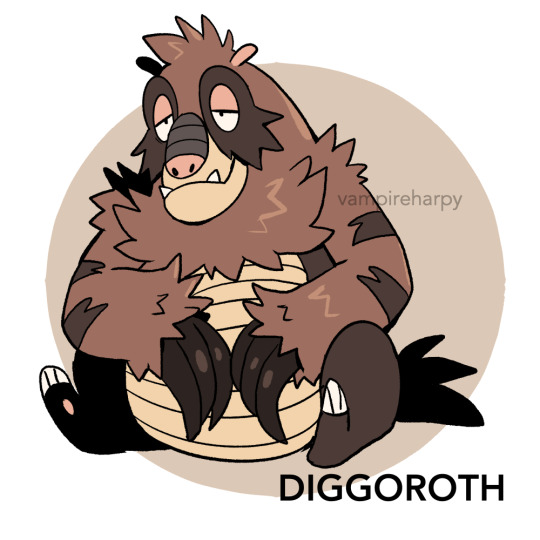


some new evolutions in my paleo-themed fakemon dex!
Diggoroth (Ground type) and Thalasskoth (Ground/Water) are based on giant ground sloths (and in the case of the latter, aquatic giant ground sloths!) They are a split evolution from Slakoth.
Omaspire (Rock/Water) is an evolution of Omastar, based on orthocones.
You can read more about them in the zine.
185 notes
·
View notes
Text
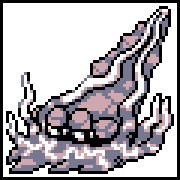

an orthocone/lava cone! it holds the two longest tentacles up on the shell to simulate flowing lava.
24 notes
·
View notes
Text
One paleoart for each period since the Cryogenian
Thanks to the timeline on my walls that I've been trying to fill in with my art, I have now reached the point where I've done paleoart for every single period of the Phanerozoic, plus the Ediacaran and Cryogenian! That is to say, every period of the last 700 million years. So with that milestone, I thought it'd be fun to go through those periods in order and show off one paleoart of mine for each!
Cryogenian

In the Cryogenian, the Earth completely froze over. Twice! Life wasn't much to look at yet, but I enjoyed drawing what our planet might have looked like at the time. The girdle of lakes at the left is the equator, which may have had ice-free patches.
Ediacaran
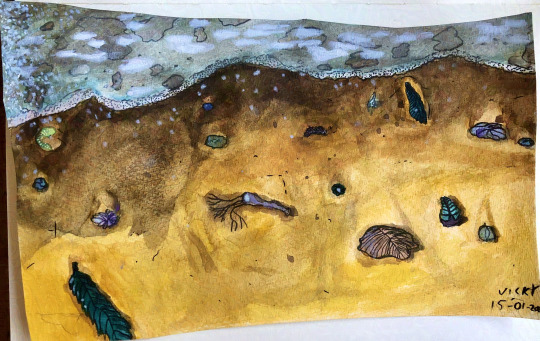
When the ice retreated, animals first began to blossom into their endless forms most beautiful. Ediacaran life was strange and quite unlike the creatures that would come later, but it was nonetheless an incredibly important chapter in life's history. Here we see the Ediacaran weirdos washing up on shore after a storm.
Cambrian

The Cambrian explosion brought much more recognisable creatures. But one thing that's easy to miss is that they were all tiny! All of them? No, Anomalocaris was, with a length of about 40 cm, the dragon of the Cambrian.
Ordovician

Life continued to diversify in the Ordovician, and among this diversity were the cephalopods. They produced the largest animals yet to exist, the orthocones, who hung vertically in the water column and decended upon their prey like a claw game.
Silurian
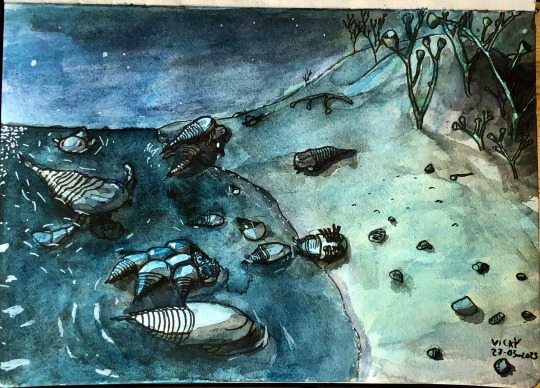
Although fungi and bacteria had already made forays onto the land deep in the past, things began to get busier there in the Silurian. But these horseshoe crabs, and their larger cousins the sea scorpions, have not come to the shore to stay, but to mate and lay eggs. Unfortunately for the horseshoe crabs, they have come to the very same shore.
Devonian
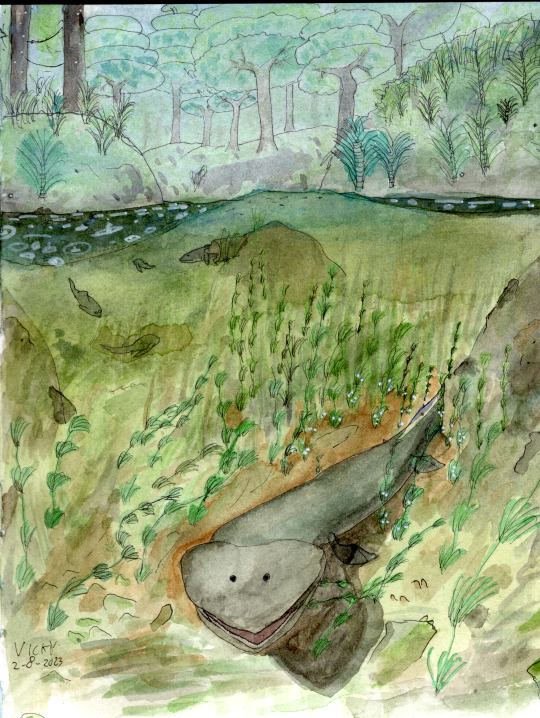
Our own vertebrate ancestors, like Tiktaalik, were pretty late to the party, only taking their first steps on land in the late Devonian. That's no knock against them - there was plenty to do underwater! This Tiktaalik is busy guarding his eggs while his mate is busy hunting, for example. Who has time to step on land?
Carboniferous

The end of the Carboniferous saw some quite large bugs, like these two Mazothairos chasing off an interloping Meganeura. They're representatives of a pretty interesting group of basal insects called the Palaeodictyoptera, who have a set of weird little extra wings on their thorax.
Permian
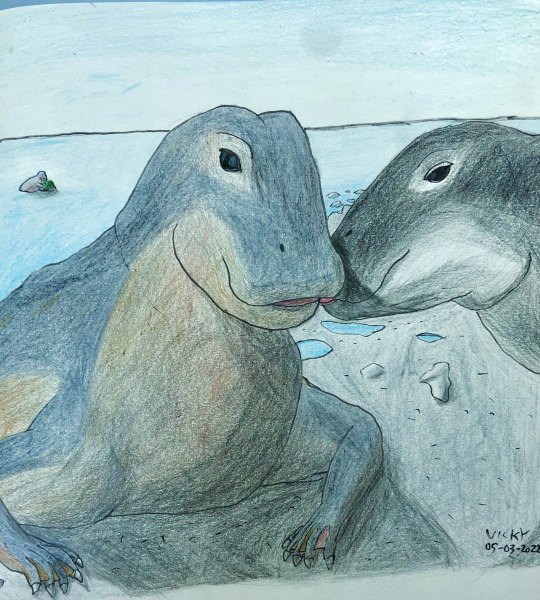
Among the many fantastic creatures of the Permian were our own cousins, the synapsids, like these lovey-dovey Moschops. As you can see, this picture and the previous one are done in coloured pencils instead of watercolour, because they're the oldest images I'm including in this post. I only very rarely used watercolours before this year. I think it means I should do some more Permian art, it's such a cool and underexposed period.
Triassic
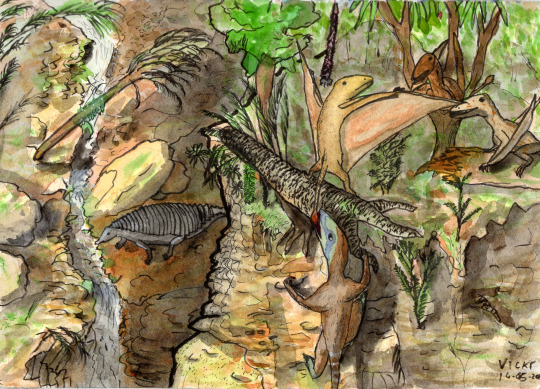
One mass extinction later, the archosaurs are diversifying all over Triassic Pangaea. Here we have the three main groups of them: Paratypothorax, a pseudosuchian in the background; Peteinosaurus, a pterosaur on top of the cliff; and Procompsognathus, a dinosaur climbing the cliff.
Jurassic

I had three different option for Jurassic paleoart to showcase, so I picked the most experimental one. These backlit insects are not butterflies, but kalligrammatids, a group of large-winged neuroptera, some of which even mimicked maniraptoran dinosaurs like this iridescent Caihong with their patterns.
Cretaceous
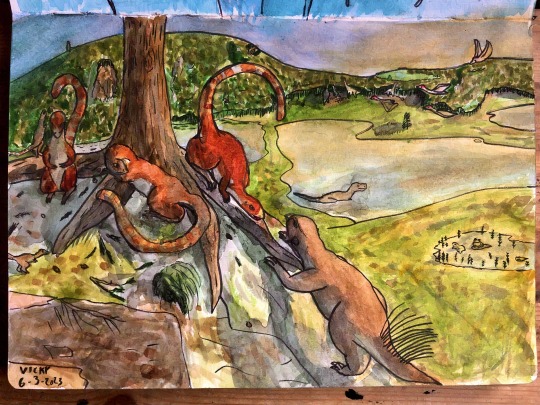
The Cretaceous featured some of life's most gorgeous crescendos of diversity, like the Yixian formation, where a Psitaccosaurus wants to visit the favourite tree of a group of Sinosauropteryxes, who are having none of it. This is still one of my favourite pieces I've ever drawn.
Paleogene
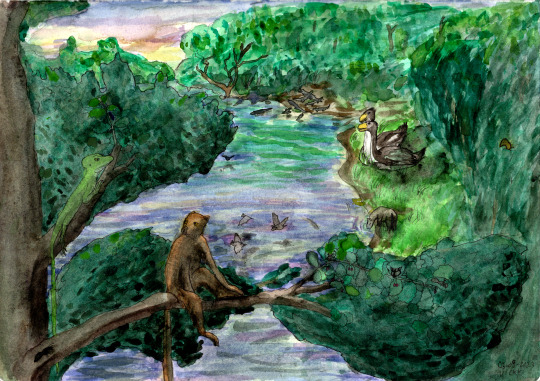
The Paleogene featured some of the highest global temperatures of all time, leading to tropical climates all over the planet, including at this lake in what will one day be Messel, Germany. Darwinius, a close cousin to our own ancestors, is having a staredown with the lizard Geiseltaliellus.
Neogene

The world turned colder and dryer in the Neogene, leading to the spread of large grasslands, like these South American ones. Phorusracos, a large terror bird, has caught a Thoatherium on the edge of the forest they both live in. South America was an isolated continent for the duration of the Neogene, leading to a quite unique fauna.
Quaternary

The Quaternary, our current period, is marked by the cycle of ice ages regularly freezing the northern hemisphere. But even during the ice ages, spring would come to the mammoth steppes, and these steppe mammoths are happy to celebrate its coming with a bath in the river.
#paleoart#my art#palaeoblr#timeline#no i am not gonna tag everything in it#the pictures should all work as links to the individual posts of these pieces#cw: animal death#cw: bugs#cw: parasites#cw: blood
305 notes
·
View notes
Text

A scene from the carboniferous
prints available!
https://www.inprnt.com/gallery/starfielddomicile/after-the-storm-the-carboniferous/
Species depicted:
A couple of Hibbertopterus wading through the shallows,
a shy Arthropleura hiding under the debris,
a young Eryops, scurrying off with a piece of:
the enormous lungfish Rhizodus,
Some generic orthocones and nautiloids,
a beached xenacanthus,
the spider-like megarachne,
a few mazothairos,
a sneaky pulminoscorpius,
And of course everyone's favorite Meganeura, carrying an unlucky tullimonstrum
#paleoart#paleontology#prehistoric#animals#bugs#insects#zoology#ancient#paleozoic#science art#creatures#critters#extinct#lifeforms#botany#amphibian#fish#mollusks#invertebrate#blender3d#procreate#fossil#fossil fuel#swamp#bog#marsh#soggy#moist#wetlands#I wish I had a time machine
82 notes
·
View notes
Text

SYNOPSIS:
CotL Prehsitoric is an alternative universe in which dinosaurs from all perioids rule, and mammals are the persecuted and sacrificial race. Narinder, outcast for his predictions of death- is blamed for the cause of death itself. He predicts a future in which all of prehistoric life is destroyed and mammals rule the earth (the big mass extinction). The bishops believe that by inprisoning him, and killing all of the mammals (aka "the vermin") will stop this prophecy from becoming true. However, by killing mammals, they led vessels directly to him- that aim to set him free.
CHARACTERS:
Lamb (the last Morganucodon)
Ratau & Ratoo (the last Zalambdalestes)
Narinder (Microraptor)
Leshy (archaeopteryx)
Shamura (n/a) (Sinomacrops)
Heket (n/a) (possibly a beelzebufo)
Kallamar (n/a) (giant orthocone squid)
Aym & Baal (archaeopteryx)
Forneus (archaeopteryx)
7 notes
·
View notes
Text
Beta pokemon: drill squid evo line, drill pokemon(ice->ice/steel)

Based on: giant orthocone, squid, drill, icicle
3 notes
·
View notes